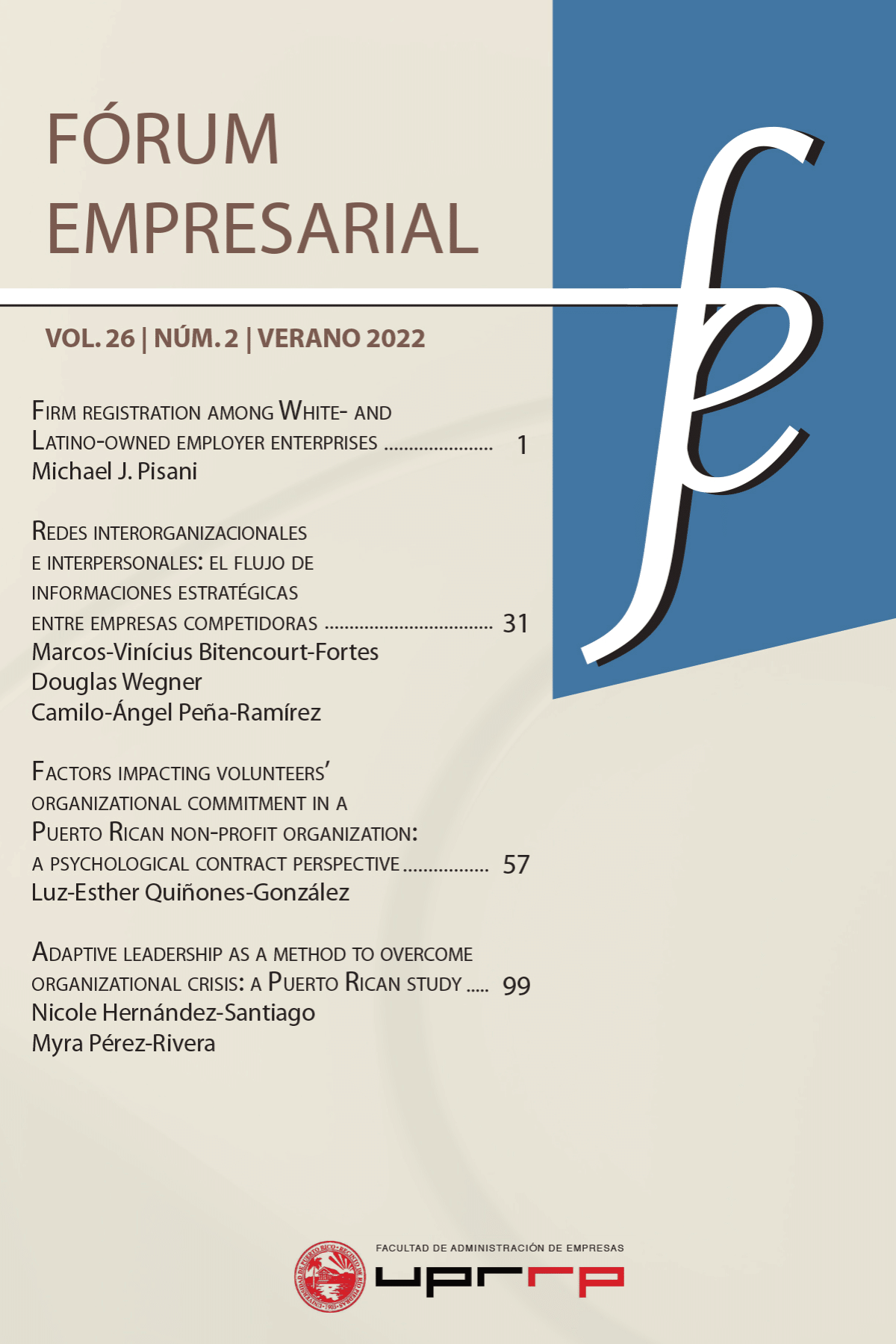Abstract
The connections between companies called board interlock allow to obtain resources and create relationships. This practice, whether intentional or not, generates connections that involve the strategic core of the company. Thus, there is a channel for the flow of strategic information, even between competitors. Previous studies have identified the creation of these connections, but without exploring them at the level of individuals. Through an analysis of social networks (n=2184), results have been presented that help to identify different national contexts (the United States and Germany), where interpersonal networks have similar structures, although inter-organizational networks are structurally different. This finding is essential to map the control over the flow of strategic information. Finally, a new role of intermediation in triads is identified from the contextual analysis of the figure of the broker in a board interlock relationship.
References
Aranha, C. E., Rossoni, L., & Mendes-Da-Silva, W. (2016). Capital social do conselho de administração e desempenho de empresas de capital aberto brasileiras. RAM. Revista de Administração Mackenzie, 17(1), 15–39.
Balestrin, A., Verschoore, J. R., & Reyes Junior, E. (2010). O campo de estudo sobre redes de cooperação interorganizacional no Brasil. Revista de Administração Contemporânea, 14(3), 458–477.
Belso-Martínez, J. A., Mas-Verdu, F., & Chinchilla-Mira, L. (2020). How do interorganizational networks and firm group structures matter for innovation in clusters: different networks, different results. Journal of Small Business Management, 58(1), 73–105. https://doi.org/10.1080/00472778.2019.1659673
Borgatti, S. P., Everett, M. G., & Freeman, L. C. (2002). Ucinet 6 for Windows: software for social network analysis. Analytic Technologies.
Brass, D. J., Galaskiewicz, J., Greve, H. R., & Tsai, W. (2004). Taking stock of networks and organizations: a multilevel perspective. Academy of Management Journal, 47(6), 795–817. https://doi.org/10.5465/20159624
Burt, R. S., Kilduff, M., & Tasselli, S. (2013). Social network analysis: foundations and frontiers on advantage. Annual Review of Psychology, 64, 527–547. https://doi.org/10.1146/annurevpsych-113011-143828
Cox Pahnke, E., McDonald, R., Wang, D., & Hallen, B. (2015). Exposed: venture capital, competitor ties, and entrepreneurial innovation. Academy of Management Journal, 58(5), 1334– 1360. https://doi.org/10.5465/amj.2012.0777
Ding, H., Hu, Y., Yang, X., & Zhou, X. (2021). Board interlock and the diffusion of corporate social responsibility among Chinese listed firms. Asia Pacific Journal of Management, 1–34. https://doi.org/10.1007/s10490-021-09767-9
Gould, R. V., & Fernandez, R. M. (1989). Structures of mediation: a formal approach to brokerage in transaction networks. Sociological Methodology, 89–126.
Farina, M. C., Melo, R. S. D., & Dutra, F. G. A. (2021). Lacunas de conhecimento e cooperação: análise de uma rede social em um instituto de tecnologia da região do ABC Paulista. Interações (Campo Grande), 22(3), 941–957.
Granovetter, M. (2007). Ação econômica e estrutura social: o problema da imersão. RAE Eletrônica, 6(1).
Gulati, R., Lavie, D., & Madhavan, R. R. (2011). How do networks matter? The performance effects of interorganizational networks. Research in Organizational Behavior, 31, 207–224. https://doi.org/10.1016/j.riob.2011.09.005
Hernandez, E., Sanders, W. G., & Tuschke, A. (2015). Network defense: pruning, grafting, and closing to prevent leakage of strategic knowledge to rivals. Academy of Management Journal, 58(4), 1233–1260. https://doi.org/10.5465/amj.2012.0773
Hofstede, G. (2016). Hofstede Index. Recuperado el 20 de mayo de 2020 de https://geert-hofstede.com.
Huijzer, M. J., & Heemskerk, E. M. (2021). Delineating the corporate elite: inquiring the boundaries and composition of interlocking directorate networks. Global Networks, 21(4), 791–820. https://doi.org/10.1111/glob.12316
Kirkels, Y., & Duysters, G. (2010). Brokerage in SME networks. Research Policy, 39(3), 375–385. https://doi.org/10.1016/j.respol.2010.01.005
Lai, C. H., & Fu, J. S. (2021). Exploring the linkage between offline collaboration networks and online representational network diversity on social media. Communication Monographs, 88(1), 88–110. https://doi.org/10.1080/03637751.2020.1869797
Meeusen, W., & Cuyvers, L. (1985). The interaction between interlocking directorships and the economic behaviour of companies. En F. N. Stokman, R. Ziegler, & J. Scott (Eds.), Networks of corporate power (pp. 45-72). Polity.
Mizruchi, M. S. (1996). What do interlocks do? An analysis, critique, and assessment of research on interlocking directorates. Annual Review of Sociology, 22(1), 271–298. https://doi.org/10.1146/annurev.soc.22.1.271
Newman, M. E. (2003). The structure and function of complex networks. SIAM Review, 45(2), 167–256. https://doi.org/10.1137/S003614450342480
Opsahl, T., & Panzarasa, P. (2009). Clustering in weighted networks. Social Networks, 31(2), 155–163. https://doi.org/10.1016/j.socnet.2009.02.002
Pacheco, G. J. A. (2018). Nivel micro, meso, macro y meta en las redes turísticas. Revista Turydes: Turismo y Desarrollo, 11(25).
Raab, J., & Kenis, P. (2009). Heading toward a society of networks: empirical developments and theoretical challenges. Journal of Management Inquiry, 18(3), 198–210. https://doi.org/10.1177/1056492609337493
Shipilov, A., & Gawer, A. (2020). Integrating research on interorganizational networks and ecosystems. Academy of Management Annals, 14(1), 92–121. https://doi.org/10.5465/annals. 2018.0121
Todeva, E. (2006). Business networks: strategy and structure. Routledge.
Vadasi, C., Bekiaris, M. & Andrikopoulos, A. (2019). Corporate governance and internal audit: an institutional theory perspective. Corporate Governance, 20(1), 175–190. https://doi. org/10.1108/CG-07-2019-0215
Valeeva, D., Heemskerk, E. M., & Takes, F. W. (2020). The duality of firms and directors in board interlock networks: a relational event modeling approach. Social Networks, 62, 68–79. https://doi.org/10.1016/j.socnet.2020.02.009
Verwaal, E. (2003). The Blackwell handbook of strategic management. Long Range Planning, 36(3), 314–316. https://doi.org/10.1111/b.9780631218616.2006.x
Williams, T. (2005). Cooperation by design: structure and cooperation in interorganizational networks. Journal of Business Research, 58(2), 223–231. https://doi.org/10.1016/S0148- 2963(02)00497-6
Withers, M. C., Hillman, A. J., & Cannella Jr, A. A. (2012). A multidisciplinary review of the director selection literature. Journal of Management, 38(1), 243–277. https://doi.org/10.1177/0149206311428671
Wu, Y., Zhang, Y., & Chen, Y. (2021). The influence of board interlocking network centrality on foundation performance: evidence from China. Journal of Chinese Governance, 6(1), 43–57. https://doi.org/10.1080/23812346.2020.1841483

This work is licensed under a Creative Commons Attribution-NonCommercial-ShareAlike 4.0 International License.
Copyright (c) 2022 Fórum Empresarial

